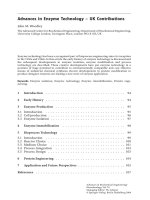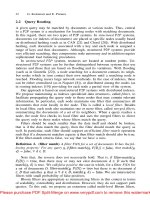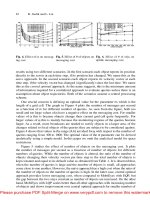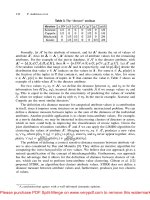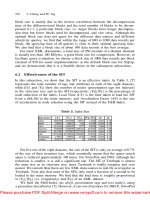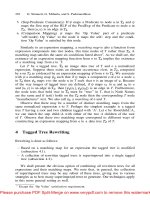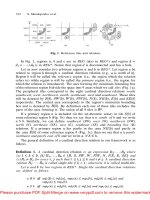Advances in Enzyme Technology – UK Contributions
Bạn đang xem bản rút gọn của tài liệu. Xem và tải ngay bản đầy đủ của tài liệu tại đây (129.43 KB, 16 trang )
Advances in Biochemical Engineering/
Biotechnology,Vol. 70
Managing Editor: Th. Scheper
© Springer-Verlag Berlin Heidelberg 2000
Advances in Enzyme Technology – UK Contributions
John M. Woodley
The Advanced Centre for Biochemical Engineering, Department of Biochemical Engineering,
University College London, Torrington Place, London WC1E 7JE, UK
Enzyme technology has been a recognised part of bioprocess engineering since its inception
in the 1950s and 1960s. In this article the early history of enzyme technology is discussed and
the subsequent developments in enzyme isolation, enzyme modification and process
technology are described. These creative developments have put enzyme technology in a
position of huge potential to contribute to environmentally compatible and cost effective
means of industrial chemical synthesis. Recent developments in protein modification to
produce designer enzymes are leading a new wave of enzyme application.
Keywords.
Enzyme isolation, Enzyme technology, Enzyme immobilisation, Protein engi-
neering.
1Introduction . . . . . . . . . . . . . . . . . . . . . . . . . . . . . . . . 94
2Early History . . . . . . . . . . . . . . . . . . . . . . . . . . . . . . . . 94
3 Enzyme Production . . . . . . . . . . . . . . . . . . . . . . . . . . . . 95
3.1 Introduction . . . . . . . . . . . . . . . . . . . . . . . . . . . . . . . . 95
3.2 Cell production . . . . . . . . . . . . . . . . . . . . . . . . . . . . . . . 96
3.3 Enzyme Isolation . . . . . . . . . . . . . . . . . . . . . . . . . . . . . . 97
4 Enzyme Immobilization . . . . . . . . . . . . . . . . . . . . . . . . . 98
5 Bioprocess Technology . . . . . . . . . . . . . . . . . . . . . . . . . . 99
5.1 Introduction . . . . . . . . . . . . . . . . . . . . . . . . . . . . . . . . 99
5.2 Reactor Choice . . . . . . . . . . . . . . . . . . . . . . . . . . . . . . . 100
5.3 Medium Choice . . . . . . . . . . . . . . . . . . . . . . . . . . . . . . 101
5.4 Process Integration . . . . . . . . . . . . . . . . . . . . . . . . . . . . 103
5.5 Process Design . . . . . . . . . . . . . . . . . . . . . . . . . . . . . . . 103
6Protein Engineering . . . . . . . . . . . . . . . . . . . . . . . . . . . . 104
7 Application and Future Perspectives . . . . . . . . . . . . . . . . . . . 105
References . . . . . . . . . . . . . . . . . . . . . . . . . . . . . . . . . . . . 107
1
Introduction
Some 2500 enzymes have been identified to date [1] and currently around 250
are used commercially in various degrees of purity. However, only 25 enzymes
account for 80% of all applications mainly in the processing of starch and for
use as domestic and industrial detergent additives for cleaning clothes. The
application of enzymes for industrial use is perhaps the widest definition of the
term enzyme technology. The term has in the past 40 years been variously
replaced by biocatalysis, bioconversion and biotransformation. Confusion has
arisen where these latter terms may also be used to describe intact microbial
cell catalysed reactions as well as isolated enzyme catalysed conversions. In this
article I will focus on the use of enzymes (whether used in an intact cell or
isolated) as potential catalysts for single step conversions and chart their
development over the past 40 years. This has been a field of intense industrial
and academic interest (from around 50 publications per year in the 1950s to a
steady 750 per year in the 1990s [2]) and I will therefore necessarily be some-
what selective here.
2
Early History
While enzymes in various forms have been used for many thousands of years
for the benefit of mankind, the application of enzyme technology to assist
industrial and process chemistry is more recent. In the late nineteenth and early
twentieth century there were a few isolated reports, but the first enzyme-based
reactions of industrial importance were steroid modifications where the
enzyme replaced a series of chemical steps required to introduce a hydroxyl
group at a specific position [3]. Achieving such specificity is very difficult by
conventional chemistry. The catalytic agent used was Rhizopus nigricans and
the cells were grown in the presence of the reactant. This simple approach
proved effective but widespread application was going to be limited to particu-
lar cases. For catalytic use it was recognised that ideally an isolated enzyme was
required. Leaving aside the need to isolate the enzyme from the cells in the first
place, it was also necessary to stabilize the enzyme (now that it was removed
from the protective environment of the cell). One method to achieve this is to
attach the enzyme to a solid support. Enzyme immobilization on, or in, a sup-
port not only provides a catalyst of sufficient size for ease of separation down-
stream of the reactor, but also keeps the enzyme structure rigid and therefore
confers stability. The drive to achieve an immobilized enzyme began in the
1960s [4]. George Manecke described enzyme resins [5]. Malcolm Lilly [6] and
Ephraim Katchalski [7] referred to water-insoluble enzyme derivatives and a
fourth pioneer, Klaus Mosbach, described entrapped and matrix bound en-
zymes [8, 9]. However it was at a meeting in 1971 that the term immobilized
enzyme was first used and became the standard nomenclature [10]. The 1971
meeting held at Hennniker in New Hampshire (USA) from August 9–13 became
the first in a valuable series of Enzyme Engineering meetings held under the
94
J.M. Woodley
auspices of the Engineering Foundation (now United Engineering Foundation).
These biannual meetings, which are still running today, have formed the back-
bone of a strong international community in enzyme technology and we owe
much to those early pioneers at that first meeting. The meetings aim to cross
disciplinary boundaries and have served as an excellent forum for exchange of
ideas. The subsequent years have seen a number of developments in enzyme
production, enzyme modification and bioprocess technology. These have led to
nine significant areas of advancement based on rDNA technology and process
engineering research.These advances are listed in Table 1 and I will describe the
development of each of these areas in this article.
3
Enzyme Production
3.1
Introduction
Despite early recognition of the need to isolate enzymes for use as biocatalysts,
in a number of cases this is not the most effective catalyst form and several con-
version types rely on operation in an intact cell (where the isolated enzyme is
unstable or use is made of other endogenous enzyme activities (for example for
cofactor recycle and regeneration)). There are three modes of operating an
intact cell process: growing cell (where the cells are growing while conversion
occurs), resting cell (where the cells are metabolically active but not growing
while the conversion occurs) and resuspended resting cell (where the resting
cells are resuspended in buffer to avoid the problems of product isolation from
medium downstream from the reactor). The options are illustrated in Figure 1.
Alternatively the enzyme may be isolated from the host organism prior to
biotransformation, in order to reuse catalyst efficiently and/or reduce con-
taminating activities. This is particularly critical where enzymes are used as
Advances in Enzyme Technology – UK Contributions
95
Table 1.
Advances in enzyme technology
Process Advance
Growth process High cell density growth
Enzyme isolation Improved enzyme expression
New enzyme isolation techniques
Enzyme immobilization
Biotransformation Protein engineering
Use of non-aqueous media
New reactor designs
New reactor operating strategies
Catalyst recycle Enzyme immobilization
Downstream processing Integration of reaction with product recovery
catalysts to assist in the synthesis of pharmaceuticals and final product purity
will determine application. Regardless of the final biocatalyst form, the process
begins with the production of the cell mass.
3.2
Cell production
A key development and significant reduction in the cost of biocatalyst produc-
tion has come through the application of so called high cell density growth [11,
12] where bacteria can now be grown at large scale up to 100 g dry weight per
litre. This is an order of magnitude improvement on previous biocatalyst
production methods. Clearly it is necessary to control the growth rate of such
processes to ensure that the oxygen demand is not too high, particularly with fast
growing cells such as the commonly used strains of Escherichia coli.Routinely
this is achieved through feeding the carbon source at a predefined rate to pre-
vent oxygen demand outstripping supply. At large scale this has been found to
be particularly important. Using such techniques, far higher titres of catalytic
protein can be obtained from the cells. For those systems with well understood
genetics a choice of host organism has also become possible on the basis of
good expression or an operationally robust strain. Additionally the application
of rDNA technology has now led to enzymes being induced more easily and
cheaply (at large scale) and expressed at far higher levels in the cytoplasm,
periplasmic space or even extracellularly. For instance at University College
London we have cloned and overexpressed transketolase (for asymmetric car-
bon-carbon bond synthesis [13]) as high as 40% of the protein in the cell [14].
At such levels of expression inclusion bodies may be formed in some systems.
However even when 15–20% of the protein is expressed as the desired enzyme,
subsequent purification may be limited to removal of protease activity alone.
Potentially such developments herald the advent of direct immobilisation from
unpurified homogenised cells. One commercial process (operated by Glaxo
96
J.M. Woodley
Figure 1.
Typical flowsheets for the three modes of intact cell-based biocatalysis
Growing cell Resting cell Resuspended resting cell
Cell production/ Cell production Cell production
Biotransformation
ØØ
Ø
Biotransformation Cell recovery
Cell recovery
ØØ
Ø
Cell recovery Resuspension
Product concentration
ØØ
Ø
Product concentration Biotransformation
Product isolation
ØØ
Product isolation Cell recovery
Ø
Product concentration
Ø
Product isolation
Wellcome in the UK) now uses this for the production of neuraminic acid
aldolase for condensation of pyruvate with mannosamine to synthesise N-
acetyl-
D
-neuraminic acid (sialic acid) as a precursor to the anti-flu compound,
zanamavir [15].
3.2
Enzyme Isolation
In a limited number of cases enzymes are secreted into the growth medium,
although at low concentration. However more frequently the useful enzyme
activity is intracellular. Figure 2 is a schematic representation of a general flow-
sheet for an intracellular enzyme-based process. While a variety of enzyme
sources is available, microbial routes are the most productive since the cells are
quick to grow, genetics well understood (in some but not all cases), the cells can
be broken and the debris separated from catalytic protein effectively. For these
reasons most processes commence with a microbial growth process. In those
cases where intracellular enzyme isolation is required (for example where
transport into the cells is limited or there are competing enzyme-catalysed re-
actions) the growth process is followed by cell concentration prior to disruption
and removal of cellular debris. Isolation of intracellular enzymes was intially
done by chemical lysis. This was a difficult process and the ability to dissrupt
cells via homogenisation [16] enabled cytoplasmic enzymes to be isolated for
the first time [17]. This operation has been well characterised and is today
standard practice for recovery of intracellular enzyme. The ability to clone into
alternative hosts will also have importance here since some cells have been
found to be much easier to break open than others [18]. Centrifugation to
Advances in Enzyme Technology – UK Contributions
97
Figure 2.
Typical flowsheet for isolated intracellular enzyme-based biocatalytic processes
Cell production
Ø
Concentration/Cell recovery –––
Æ
Water
Ø
Disruption
Ø
Removal of cell debris –––
Æ
Cell debris
Ø
Immobilisation
¨
––– Enzyme support
Ø
Biotransformation
¨
––– Reactant
Ø≠
Catalyst recovery
Ø
Concentration –––
Æ
Water
Ø
Product isolation –––
Æ
Side products
Ø
Product
separate the cell debris, prior to purification has also become routine. Entrained
air in homogenization and centrifugal operations is a particular problem since
globular proteins are very susceptible to shear induced interfacial effects [19].
Surprisingly most enzymes have been found to be resistant to shear itself with
the exception of some membrane bound enzymes [20]. Subsequent purification
of the enzyme is required only to the extent of removing protease activity or
contaminating activities that may affect the final yield of product. This is in
sharp contrast to other biotechnological processes where protein purification is
a dominant process issue. These techniques now mean that many enzymes can
be recovered and isolated effectively for subsequent use as a suspended catalyst
or immobilized onto a solid support.
4
Enzyme Immobilization
For intracellular isolated enzyme based catalysis the cost and difficulty of
enzyme isolation means that the catalyst becomes a very significant part of the
total cost. Hence there is a need to reuse and retain such enzymes. While this
was the original justification for enzyme immobilization (necessary also with
continuous reactors such as packed or fluidised beds [21]) this is only possible
if the enzyme has sufficient stability. Fortunately in many cases the im-
mobilization itself holds the structure of the protein in place and hence leads to
significant improvements in the stability of the enzyme. In the 1960s the first
work on ‘insoluble enzymes’ showed that using charged support materials the
pH optimum and/or Michaelis constant could be shifted [22] for a particular
enzyme. However these electrostatic effects, while academically interesting, did
not lead to industrial development due to the high substrate concentrations
required for commercial process operation. In 1969 the NSF in the USA began
funding of enzyme engineering leading to a considerable interest in the
development of immobilized systems. Table 2 lists some of the features of
immobilised biocatalysts. One of the earliest applications was by the Tate and
Lyle Sugar Company (in the UK) who operated a 6 metre deep bone char im-
98
J.M. Woodley
Table 2.
Features of immobilized biocatalysts
Process operation Feature
Catalyst production Loss of activity upon immobilization
Additional cost of support
Reactor operation Reduced activity per unit volume
Diffusional limitations
Increased stability
Protection from interfacial damage
a
Options for alternative reactors
b
Downstream Improved separation
a
Gas-liquid and liquid-liquid.
b
Packed and fluidised beds.
